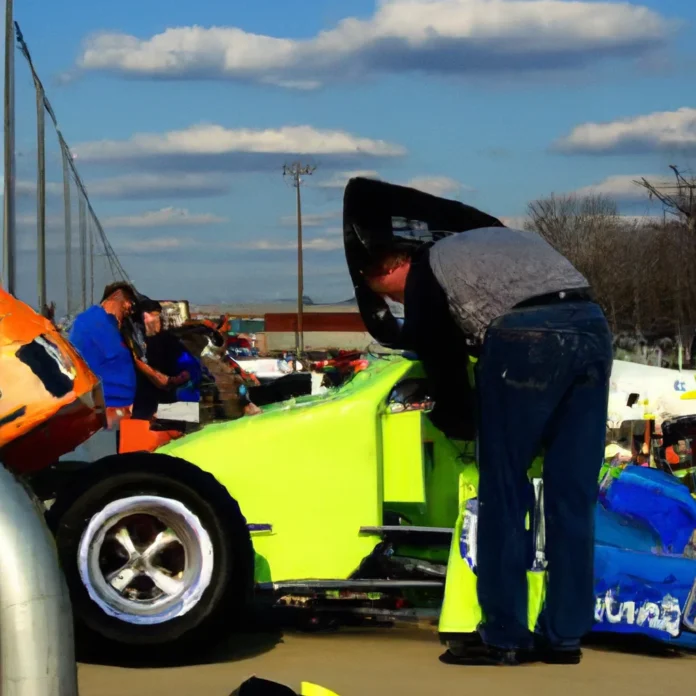Introduction: Why Start Your Amateur Racing Journey?
There is a unique thrill in gripping the steering wheel, feeling the engine’s vibration beneath you, and hearing the symphony of revving motors at the starting line. Amateur racing offers an accessible path for car enthusiasts who crave speed, competition, and camaraderie, but do not want to commit to professional motorsport’s demands. It is more than just a pastime; it is a structured, exhilarating pursuit that pushes us to improve our driving skills and savor every adrenaline-charged moment on the track.
For many, the journey begins with curiosity and the desire to test our limits in a safe, supportive environment. Whether we are motivated by the buzz of competition or the simple joy of driving, amateur racing offers a welcoming entry point into the world of motorsports.
What is Amateur Racing?
Amateur racing encompasses a variety of motorsport activities open to non-professionals. These events are organized for drivers who want to experience the intensity of racing without the pressure or financial burden of a professional career. Races usually occur at local tracks or temporary circuits, and participants range from complete novices to seasoned hobbyists.
Understanding the types of amateur racing available helps us find the discipline that best fits our interests and abilities.
Types of Amateur Racing You Can Try
Each racing discipline offers its own atmosphere, challenges, and rewards. Here are some of the most popular forms to consider:
Circuit Racing
Circuit racing takes place on closed tracks with multiple turns and straightaways. Drivers compete in multiple laps, focusing on speed, precision, and strategy. The roar of engines and scent of burning rubber fill the air, making for an electrifying experience.
Autocross
Autocross is typically held in large parking lots or open spaces, where drivers navigate a twisty course marked by cones. It’s about agility and precision rather than outright speed, making it ideal for beginners seeking an affordable entry point.
Rally Racing
Rally racing involves timed stages on a mixture of tarmac, gravel, and dirt roads. Drivers and co-drivers work together, reacting quickly to changing conditions and unpredictable terrain.
Drag Racing
Drag racing focuses on straight-line acceleration over a short distance (usually a quarter mile). The sensation of launching off the line and the rush of rapid acceleration are unmatched.
Karting
Karting is accessible, affordable, and highly competitive. Drivers steer small, nimble karts around tight circuits, honing their skills in close-quarters racing.
Endurance Racing
Endurance racing tests both vehicle reliability and driver stamina, with races lasting several hours or even days. Teamwork and consistency become just as important as outright speed.
Step 1: Discover Your Racing Passion
The first step toward a successful racing journey is identifying which discipline truly excites you. Taking time to reflect on our preferences can save us time and money, and lead to a more rewarding experience on the track.
How Do You Choose the Right Racing Discipline?
With so many options, narrowing down our choices requires honest self-assessment and practical research. We should consider not only what appeals to us visually or emotionally, but also what fits our lifestyle and resources.
Assessing Your Interests and Skills
Think about your driving strengths. Do you enjoy technical precision, or do you thrive in fast-paced, high-adrenaline situations? If you love problem-solving under pressure, rally might suit you. If you prefer controlled environments, circuit or autocross racing could be a better fit.
Researching Local Racing Opportunities
Check what clubs, tracks, and events exist in your area. Some disciplines may be more prevalent locally, which can influence your decision. Online forums, social media groups, and motorsport associations are excellent resources for discovering these opportunities.
Understanding Time and Budget Commitments
Each racing discipline comes with its own time and financial requirements. Karting and autocross often have lower start-up costs, while endurance and rally racing may demand more substantial investments. Setting realistic expectations helps us avoid disappointment down the road.
For those interested in the financial side of motorsport, including the expenses involved in hiring professional help, we suggest reading our detailed analysis on how much a driver really costs.
Step 2: Learn the Basics of Racing
Before we hit the track, it is essential to develop a solid understanding of racing rules and etiquette. This knowledge not only keeps us and others safe, but also helps us earn the respect of fellow competitors.
What Are the Essential Racing Rules and Etiquette?
Familiarizing ourselves with the core principles of motorsport ensures we make a positive impression from our very first event. Respect for the rules and for other drivers is non-negotiable.
Safety Protocols Every Racer Must Know
Safety is the foundation of every motorsport event. From wearing the correct gear to understanding emergency procedures, we must prioritize safety at all times. Never cut corners or take unnecessary risks.
Flag Signals and Their Meanings
Track marshals use colored flags to communicate important information. For example, a yellow flag signals caution, while a red flag indicates the session is stopped. Knowing these signals can prevent accidents and misunderstandings.
Track Day Etiquette
On track days, patience and courtesy go a long way. Allow faster cars to pass safely, avoid aggressive maneuvers, and always follow the event organizer’s instructions. Remember, we are all there to enjoy ourselves and improve.
For additional insights on responsible and enjoyable high-performance driving, our article on the do’s and don’ts of driving your dream car offers valuable tips.
Step 3: Get the Right Equipment
Having the proper racing equipment is essential for both safety and performance. Each discipline may have specific requirements, but some basics apply to all forms of amateur racing.
What Gear Do You Need to Start Racing?
Investing in quality gear not only protects us but also provides comfort and confidence on the track. Start with the essentials and upgrade as your skills and ambitions grow.
Helmet and Safety Apparel
A certified racing helmet is non-negotiable. Fire-resistant suits, gloves, and shoes further reduce risk and are often required by event organizers. Always check that your gear meets current safety standards.
Choosing a Suitable Car or Kart
Start with a reliable, well-maintained vehicle that matches the demands of your chosen discipline. For many, a lightly modified street car or an entry-level kart is the perfect starting point.
Upgrading Your Vehicle for Racing
Basic modifications like upgraded brakes, performance tires, and improved suspension can make a significant difference. Focus on safety and reliability before chasing extra horsepower.
Essential Tools and Accessories
Bring a toolkit, tire pressure gauge, and spare fluids to every event. These simple items can save the day when unexpected issues arise.
Step 4: Find and Join Local Racing Clubs
Joining a local racing club connects us with like-minded enthusiasts, provides access to events, and accelerates our learning curve. Being part of a community makes the racing journey far more rewarding.
How Can Racing Clubs Accelerate Your Progress?
Clubs offer structured opportunities to race, learn, and socialize. The friendships and mentorships formed within these groups often last a lifetime.
Benefits of Club Membership
- Access to exclusive track days and events
- Discounted entry fees and insurance
- Guidance from experienced members
- Shared resources and technical advice
How to Find the Right Club for You
Research clubs that align with your interests and location. Attend a meeting or event as a guest to get a feel for the atmosphere and culture before committing.
Networking with Other Racers
Building relationships with fellow racers opens doors to new opportunities, from car sharing to team events. These connections can be invaluable as you progress.
Step 5: Take Professional Driver Training
Investing in driver training is one of the smartest ways to accelerate improvement. Professional instructors help us build solid foundations and correct bad habits before they become ingrained.
Why Is Driver Training Important for Beginners?
Learning from experts not only improves our technique but also builds confidence and reduces the likelihood of costly mistakes. Instructors tailor feedback to our skill level, helping us progress efficiently.
Types of Racing Schools and Programs
- One-day introductory courses
- Multi-day advanced schools
- Specialized programs for specific disciplines
These programs often combine classroom theory with on-track practice for a well-rounded experience.
Key Skills You’ll Learn in Training
Expect to cover cornering techniques, braking, throttle control, and racecraft. Many schools also teach mental preparation and focus, which are just as vital as physical skill.
As experts often say:
“The best drivers never stop learning, no matter how many races they have under their belt.”
How to Choose the Best Racing School
Look for programs with experienced instructors, modern facilities, and positive reviews from past students. Consider location and cost, but prioritize quality of instruction.
Step 6: Enter Your First Race
Taking part in your first race is a major milestone. Preparation is key to making the experience enjoyable and stress-free.
How Do You Prepare for Your First Race?
Preparation involves more than just mechanical checks. Mental readiness and logistical planning are just as important for a smooth race day.
Registering for Events
Sign up early, as spots can fill quickly. Double-check all entry requirements, including licenses, memberships, and car eligibility.
Pre-Race Checklist
- Inspect your car or kart for safety and compliance
- Pack all necessary gear and tools
- Review the event schedule and rules
- Get plenty of rest the night before
What to Expect on Race Day
The atmosphere buzzes with anticipation—engines rumble, tires squeal, and competitors line up, focused and ready. Arrive early to allow time for registration, technical inspection, and a track walk if possible. Stay calm, follow the schedule, and soak in every moment.
Step 7: Build Experience and Improve
Every lap on the track is an opportunity to learn. Growth as a racer comes from honest self-evaluation, embracing feedback, and setting new challenges.
How Can You Track Your Progress as a Racer?
Analyzing our performance helps us identify strengths and areas for improvement. Keeping detailed notes after each event can accelerate development.
Analyzing Race Results and Lap Times
Review timing sheets and video footage to understand where you gain or lose time. Small improvements in consistency can yield significant results over the course of a season.
Learning from Mistakes and Feedback
Every error is an opportunity for growth. Seek input from instructors, peers, and even competitors. Honest feedback is invaluable for long-term progress.
Setting New Goals for Improvement
Set specific, measurable goals—such as shaving a second off your lap time or mastering a difficult corner. Celebrate milestones, no matter how small.
Staying Motivated After Setbacks
Racing is as much a mental game as a physical one. Setbacks are inevitable but temporary. Stay positive, and remember why you started in the first place.
Maintaining Your Vehicle for Consistent Performance
A well-maintained vehicle is safer, faster, and more reliable. Regular maintenance prevents breakdowns and keeps us competitive throughout the season.
Basic Maintenance Tasks for Racers
- Inspect and replace fluids regularly
- Check tire pressure and tread
- Monitor brake pads and rotors
- Keep suspension components in good condition
When to Upgrade or Replace Parts
Replace parts at the first sign of wear, especially critical safety items. Upgrading components like brakes or tires can provide noticeable performance gains without huge expense.
For those who appreciate luxury automotive experiences, we’ve discussed how luxury car chauffeur services handle vehicle maintenance for peak performance.
How to Build a Support Team
No racer succeeds alone. Building a reliable support team makes the racing experience more enjoyable, efficient, and successful.
Roles of Crew Members in Amateur Racing
Your crew may include mechanics, spotters, and friends who help with logistics. Each plays a vital role in keeping your race day on track.
Finding Friends and Family Support
Enlist friends and family who share your passion. Their encouragement and hands-on help can make all the difference during stressful moments.
Hiring Professional Help
As you progress, consider hiring a professional mechanic or coach for technical guidance. Their expertise can be a worthwhile investment, especially in more competitive disciplines.
Budgeting for Your Racing Journey
Smart budgeting makes amateur racing sustainable and enjoyable. Understanding all costs up front helps us avoid surprises and keep our passion on track.
Estimating Start-Up and Ongoing Costs
Start-up costs may include licensing, safety gear, and initial vehicle preparation. Ongoing expenses cover entry fees, maintenance, travel, and consumables like tires and fuel.
How to Save Money on Racing
- Buy used equipment in good condition
- Share costs with teammates
- Perform basic maintenance yourself
- Join clubs for member discounts
Sponsorships and Funding Options
Some racers offset costs through local sponsorships or crowdfunding. Building a compelling story and actively engaging with the community can attract support from businesses and fans alike.
If you are considering travel options for events, our overview of choosing the best private jet rental might provide insights for efficient and comfortable travel planning.
Staying Safe: Key Tips for Amateur Racers
Safety should always be our top priority. Racing can be dangerous, but with the right precautions and mindset, we can minimize risks and focus on enjoyment and improvement.
What Are the Most Common Racing Risks?
Accidents, mechanical failures, and fatigue are among the most frequent risks. Recognizing them early and preparing accordingly helps keep everyone safe.
Preventing Injuries on the Track
Always use certified safety gear, follow event rules, and never push beyond your comfort level. Respect your limits and those of your vehicle.
Choosing the Right Insurance
Specialized motorsport insurance offers protection beyond standard auto policies. Research options that cover both you and your vehicle during events.
For those interested in the role of professional drivers and passenger safety, our post on how chauffeur services enhance comfort and safety offers additional perspective.
Legal and Licensing Requirements for Amateur Racing
Complying with legal and licensing requirements is essential before stepping onto any track. Regulations vary by region and discipline, so thorough research is a must.
How Do You Get Licensed to Race?
Most events require a competition license, which may involve a simple application process or completion of a certified driving course. Check with your local motorsport authority for details.
Understanding Racing Regulations in Your Area
Familiarize yourself with vehicle eligibility, safety standards, and event-specific rules. Staying informed prevents unnecessary setbacks and penalties.
Building Your Presence in the Racing Community
Sharing our journey and engaging with the racing community brings new friendships, opportunities, and support. Building a presence can even attract sponsors as we progress.
Using Social Media to Share Your Progress
Documenting your racing experiences on platforms like Instagram or YouTube helps connect with fans and other racers. Share videos, photos, and reflections to inspire and inform others.
Attending Racing Events and Expos
Participating in or visiting motorsport expos and shows provides networking opportunities and keeps us updated on the latest industry trends.
Connecting with Sponsors and Brands
Building relationships with local businesses and automotive brands can lead to sponsorships or discounts. Present yourself professionally and demonstrate your commitment to the sport.
Common Mistakes New Racers Make (and How to Avoid Them)
Many beginners make avoidable errors, such as neglecting safety, underestimating costs, or skipping proper training. We can sidestep these pitfalls by preparing thoroughly, seeking guidance, and maintaining a growth mindset.
Never hesitate to ask questions or request feedback—learning from others’ experiences is one of the fastest ways to improve.
Conclusion: Your Roadmap to Amateur Racing Success
Starting an amateur racing journey is a bold, rewarding decision. By following these seven steps—discovering your passion, learning the basics, gearing up, joining clubs, seeking training, competing, and continuously improving—you set yourself up for enjoyment and growth both on and off the track. Remember, every champion started as a beginner with a dream and a willingness to learn.
If you are ready to take your first step, or simply want to stay inspired, we invite you to connect with the team at Autoxite. We are passionate about supporting your journey toward racing success—one lap at a time.
Frequently Asked Questions About Getting Started in Amateur Racing
Q: Do I need a special license to start amateur racing?
A: Most organized events require at least a basic competition license. Check with your local motorsport authority for specific requirements.
Q: What is the most affordable way to start racing?
A: Autocross and karting are generally the least expensive entry points, thanks to lower equipment and entry costs.
Q: Can I use my daily driver for racing?
A: Many beginners start with their street cars, especially for autocross or beginner track days. Make sure your vehicle meets safety requirements.
Q: How do I find events near me?
A: Visit motorsport association websites, join local clubs, and follow social media groups dedicated to amateur racing in your area.
Q: How can I balance racing with my other responsibilities?
A: Choose a discipline that fits your schedule and budget, and communicate openly with your support network. Prioritizing preparation and organization makes it easier to enjoy racing alongside work and family commitments.


